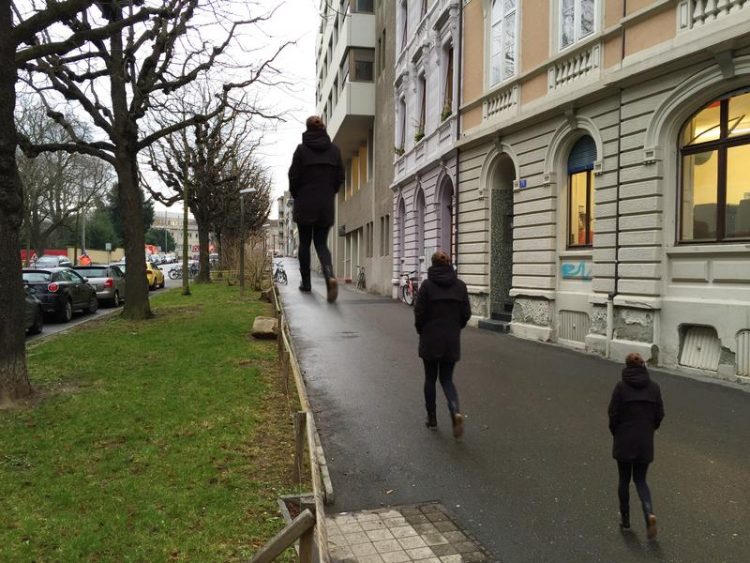Putting Vision Into Context

Context is essential: The people in the picture are the same size but appear larger with increasing distance. Universität Basel, Sonja Hofer
As soon as we open our eyes in the morning, our brain is flooded with images. Information about these images is sent from the eyes to a brain region called the thalamus, and from there on to the visual cortex. The visual cortex, which comprises the largest part of the human brain, is responsible for analyzing visual information and allows us to see.
In contrast, the thalamus has until now been considered mostly as a relay for visual information. The research team led by Prof. Sonja Hofer at the Biozentrum, University of Basel, has discovered in mice that a special part of the thalamus — called the Pulvinar — supplies the visual cortex with additional, non-visual information.
Contextual information is essential for visual perception
What we see is not only based on the signals that our eyes send to our brain, but is influenced strongly by the context the visual stimulus is presented in, on our previous knowledge, and expectations. Optical illusions, as the one shown here, illustrate how important such non-visual, contextual information is for our perception.
The visual cortex receives this additional information from other brain areas and uses it to allow us to understand and interpret the visual world. Prof. Hofer and her team measured the specific signals transmitted to visual cortex from the Thalamus, and found that the Pulvinar not only conveyed visual signals but is also one of the brain areas that provide additional information about the context of visual stimuli.
Movements in the environment can be detected effectively
Moreover, the researchers could identify this additional information in more detail. For example, the Pulvinar sends signals about sudden, unpredicted motion in the environment which is not caused by the animal’s own movements.
“Visual signals that the brain cannot predict might be especially important, such as a car that suddenly appears, or maybe an approaching predator in the case of the mouse. The Pulvinar might facilitate the detection of these stimuli,” explains Dr Morgane Roth, one of the authors of the study.
Although the Pulvinar is the largest part of the thalamus in humans, its function is still largely unknown. The researchers’ findings begin to shed some light on the role of this mysterious structure.
Another piece of the puzzle are the signals sent back to the Pulvinar from visual cortex, which seem to make information flow back and forth between the two parts of the brain in a loop. Why this is the case is still completely unclear. Prof. Hofer’s team is now planning to study these visual loops, and to find out how signals from the Pulvinar influence our visual perceptions and actions.
Original article
Morgane M. Roth, Johannes C. Dahmen, Dylan R. Muir, Fabia Imhof, Francisco J. Martini, Sonja B. Hofer
Thalamic nuclei convey diverse contextual information to layer 1 of visual cortex.
Nature Neuroscience (2015) | doi:10.1038/nn.4197
Further information
Heike Sacher, University of Basel, Biozentrum, phone: +41 61 267 14 49, email: heike.sacher@unibas.ch
https://www.unibas.ch/en/News-Events/News/Uni-Research/Putting-vision-into-conte…
Media Contact
All latest news from the category: Life Sciences and Chemistry
Articles and reports from the Life Sciences and chemistry area deal with applied and basic research into modern biology, chemistry and human medicine.
Valuable information can be found on a range of life sciences fields including bacteriology, biochemistry, bionics, bioinformatics, biophysics, biotechnology, genetics, geobotany, human biology, marine biology, microbiology, molecular biology, cellular biology, zoology, bioinorganic chemistry, microchemistry and environmental chemistry.
Newest articles

Properties of new materials for microchips
… can now be measured well. Reseachers of Delft University of Technology demonstrated measuring performance properties of ultrathin silicon membranes. Making ever smaller and more powerful chips requires new ultrathin…

Floating solar’s potential
… to support sustainable development by addressing climate, water, and energy goals holistically. A new study published this week in Nature Energy raises the potential for floating solar photovoltaics (FPV)…

Skyrmions move at record speeds
… a step towards the computing of the future. An international research team led by scientists from the CNRS1 has discovered that the magnetic nanobubbles2 known as skyrmions can be…





















